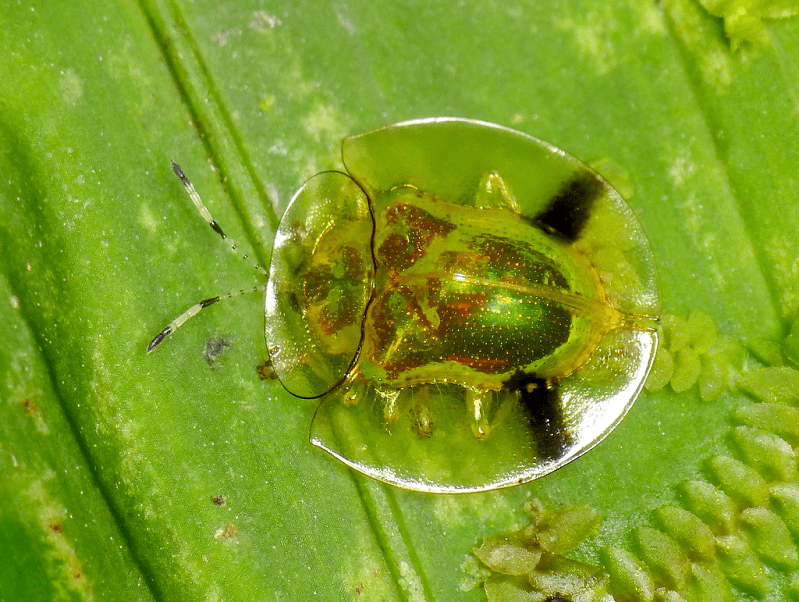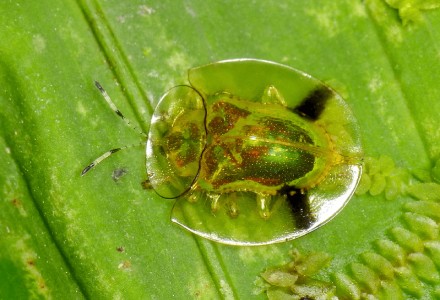
Golden Tortoise Beetle Facts
- Perhaps most notably, the Golden Tortoise Beetle represents a rather incredible looking insect. Further, entomologists presently classify it as a member of the leaf beetle family. Also, this gorgeous natural marvel of Nature remains native to a specific portion of the Northern Hemisphere.
- Fascinatingly, it also developed a very special relationship with certain flora. That’s because the unique invertebrate evolved to feed only on a specific family of plants, the Connolvulaceae. This family includes several species, including morning glories, bindweeds, and sweet potatoes.
- In fact, both the larvae and the adults feed on the foliage of these species exclusively. While not unknown, this characteristic remains uncommon enough to garner great interest among researchers. This case, therefore, makes for a rather fascinating example of coevolution.
- The species does not yet hold a listing by the IUCN on its Red List of Threatened Species. However, many experts consider it to be in danger of extinction. Climate change appears to be its greatest threat. This holds true due to the fact that changing weather patterns threaten to reduce the availability of its native habitat.
Related Articles
Tansy Beetle Goliath Beetle Atlas Beetle
Golden Tortoise Beetle Physical Description
First of all, regardless of its beauty, the gorgeous Golden Tortoise Beetle remains a rather small invertebrate. That statement holds true due to the fact that mature adults only average about 5-7 mm in length. However, unlike many related species, it displays no noticeable degree of the trait of sexual dimorphism.
In color, the awesome insect usually appears as either orange or gold in color. However, the golden hue remains by far the more common of the two color patterns. This greater tendency, therefore, serves as the source of the common name.
Furthermore, the chitin of this beetle typically displays a marvelous metallic sheen. fascinatingly, the external regions lack pigment and remain nearly transparent. The insect also has the ability to change its color to a dull brown. This represents a useful defense mechanism when under threat.
- Kingdom: Animalia
- Phylum: Arthropoda
- Class: Insecta
- Order: Coleoptera
- Family: Chrysomelidae
- Genus: Charidotella
- Species: C. sexpunctata
Photographer: Achom Halley
CC License: https://bit.ly/1xMszCg
Golden Tortoise Beetle Distribution, Habitat, and Ecology
The mesmerizingly beautiful Golden Tortoise Beetle only inhabits specific areas within the outer boundaries of North America. These areas of habitation primarily include the eastern and western United States. However, scattered populations also exist in the northern sections of Mexico.
The remarkable invertebrate also remains rather selective of its habitat. As a result of this characteristic, it only inhabits regions rich in sweet potato and related species. Sadly, though, this often brings it into conflict with humans, most specifically farmers. These farmers often view it as a pest.
After mating, the majority females lay their eggs on the underside of leaves. The eggs typically hatch after 4-5 weeks. Then, after a period of several weeks, the larvae turn into pupa. Subsequent to that, after a few weeks more, the pupa becomes the relatively short-lived adult of the species.
Finally, the adults themselves serve as prey for several insects. These predators most often include the tachnid fly and the eulophid wasp. Ladybirds, shield bugs, and damselflies remain among the principal predators of the larvae.
Species Sharing Its Range
Cougar Carolina Silverbell Bald Eagle
Check out our other articles on 5 Rare Mind-Blowing Cloud Types, Culpeo, Dallol Hydrothermal Field, Mycena Chlorophos, Eastern Diamondback Rattlesnake, Galapagos Penguin

